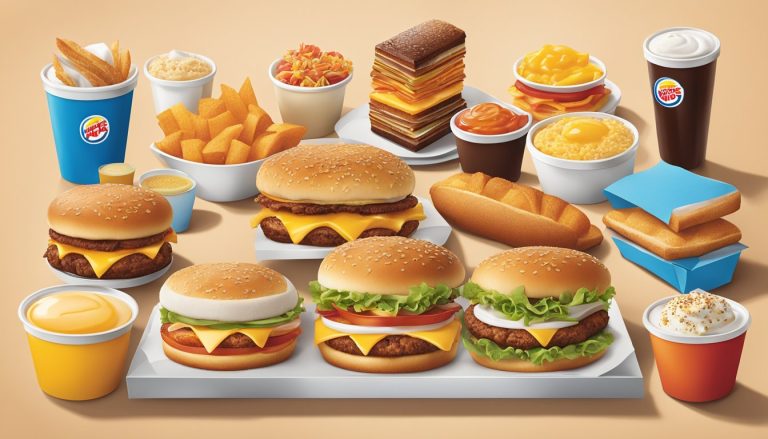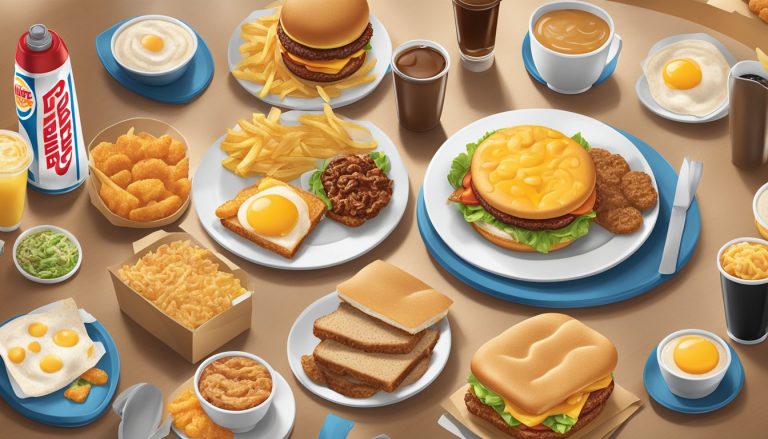Burger King has been serving breakfast since 1979, making it one of the earliest fast food chains to offer morning meals. Over the years, the restaurant has introduced various breakfast items to entice customers and compete with other chains in the breakfast market.
While some Burger King breakfast items have become menu staples, others have failed to stand the test of time. The fast food giant has discontinued several breakfast offerings throughout its history, often in response to changing consumer preferences or as part of menu streamlining efforts. These discontinued items represent Burger King’s attempts to innovate and expand its breakfast options, even if they ultimately didn’t resonate with customers.
1) Fruity French Toast Bites

Burger King once considered adding Fruity French Toast Bites to their breakfast menu. This innovative dish aimed to combine the classic appeal of french toast with a fruity twist.
The proposed menu item consisted of bite-sized pieces of french toast infused with various fruit flavors. Potential options included strawberry, blueberry, and mixed berry varieties.
Each bite was designed to be crispy on the outside and soft on the inside, with a sweet fruit flavor throughout. The idea was to create a portable, easy-to-eat breakfast option for customers on the go.
BK planned to serve these bites in a convenient cup, making them ideal for drive-thru orders. A side of syrup or fruit compote was considered as an optional add-on for extra flavor.
Despite the creative concept, Fruity French Toast Bites ultimately didn’t make it onto Burger King’s final breakfast menu. The reasons for this decision remain unclear, but it may have been due to production challenges or lack of consumer interest during test phases.
2) Maple Pancake Sausage Bites

Burger King once considered adding Maple Pancake Sausage Bites to their breakfast menu. These bite-sized treats would have combined the sweetness of maple pancakes with savory breakfast sausage.
The concept aimed to offer a portable, handheld breakfast option for customers on the go. Each bite would have featured a small sausage piece wrapped in fluffy pancake batter, infused with maple flavor.
Similar products have been successful for other brands. Jimmy Dean, for example, offers Mini Maple Pancakes and Maple Sausage Bites as part of their Morning Combos line.
Despite the potential appeal, Burger King ultimately decided not to pursue this menu item. The reasons for this decision are not publicly known, but factors such as production complexity or market research results may have played a role.
While Maple Pancake Sausage Bites didn’t make the cut, Burger King continues to offer other breakfast options. Their menu includes items like the Double Sausage Breakfast Sourdough King, which caters to customers seeking hearty breakfast sandwiches.
3) Sausage & Cheese Waffle Sandwich
Burger King once offered a unique breakfast item that combined the sweetness of waffles with savory fillings. The Sausage & Cheese Waffle Sandwich featured a sausage patty and cheese nestled between two waffle slices.
This innovative creation aimed to provide customers with a different breakfast experience. The waffle exterior offered a slightly crispy texture with a hint of maple flavor, contrasting with the juicy sausage and melted cheese inside.
Despite its intriguing concept, the Sausage & Cheese Waffle Sandwich didn’t become a permanent fixture on Burger King’s breakfast menu. The fast-food chain eventually discontinued this item, likely due to mixed customer reception or operational challenges.
While some diners appreciated the novel combination of flavors, others found the pairing of waffles with sausage and cheese less appealing. The sandwich’s limited run demonstrates the restaurant’s willingness to experiment with unconventional breakfast options.
Though no longer available, the Sausage & Cheese Waffle Sandwich remains a notable entry in Burger King’s history of menu innovations. It serves as an example of the brand’s efforts to diversify its breakfast offerings and cater to varying customer preferences.
4) Crispy Chicken & Biscuit

Burger King’s Crispy Chicken & Biscuit was a breakfast item that aimed to compete with other fast-food chains’ chicken offerings. This menu item featured a crispy chicken fillet served on a warm, buttery biscuit.
The combination of savory fried chicken and a flaky biscuit appealed to customers looking for a hearty breakfast option. Burger King introduced this item to capitalize on the growing popularity of chicken-based breakfast sandwiches.
Despite initial interest, the Crispy Chicken & Biscuit failed to gain lasting traction on Burger King’s breakfast menu. Factors such as inconsistent quality and fierce competition from other chains contributed to its discontinuation.
Burger King’s decision to remove this item from their menu reflects the challenges of maintaining a diverse breakfast lineup. While some customers may have enjoyed the Crispy Chicken & Biscuit, it ultimately did not perform well enough to secure a permanent spot on the menu.
The fast-food breakfast market remains highly competitive, with chains constantly innovating and adjusting their offerings to meet customer preferences and stand out from rivals.
5) Savory Sausage & Egg Bowl

Burger King once tested a protein-packed breakfast option called the Savory Sausage & Egg Bowl. This hearty dish aimed to cater to customers seeking a low-carb morning meal.
The bowl featured a base of scrambled eggs topped with savory sausage crumbles and melted cheese. It offered a satisfying combination of flavors and textures in a convenient format.
Despite its potential appeal to health-conscious diners, the Savory Sausage & Egg Bowl did not secure a permanent spot on Burger King’s menu. The fast-food chain ultimately decided not to roll out this item nationwide.
The bowl’s limited test run occurred in select markets, allowing Burger King to gauge customer interest. While some diners appreciated the protein-rich option, it failed to generate enough enthusiasm for a full launch.
Burger King’s decision to forgo this menu item may have been influenced by operational factors or sales projections. The company continues to explore new breakfast offerings to meet evolving consumer preferences.
6) Spicy Chorizo Cheese Wrap

Burger King once tantalized taste buds with its Spicy Chorizo Cheese Wrap, a breakfast offering that combined bold flavors in a convenient package. This handheld meal featured spicy chorizo sausage, scrambled eggs, and melted cheese, all wrapped in a warm tortilla.
The wrap aimed to cater to customers seeking a hearty, zesty start to their day. Its combination of protein-rich ingredients and piquant spices provided a satisfying morning meal option for those on the go.
Despite its appealing flavor profile, the Spicy Chorizo Cheese Wrap didn’t secure a permanent spot on Burger King’s menu. The fast-food chain periodically introduces and removes items to keep its offerings fresh and align with changing consumer preferences.
While no longer available, the wrap’s brief appearance demonstrated Burger King’s willingness to experiment with diverse breakfast options. It showcased the chain’s attempt to incorporate trending flavors and international influences into its morning lineup.
7) Sweet Cream Cheese Croissant

Burger King once experimented with a Sweet Cream Cheese Croissant breakfast item. This indulgent pastry combined the flaky, buttery texture of a croissant with a creamy, sweet cheese filling.
The croissant was sliced and filled with a smooth mixture of cream cheese, sugar, and a hint of vanilla. Some versions included a sprinkle of cinnamon for added warmth and flavor.
While it seemed promising, the Sweet Cream Cheese Croissant faced challenges in maintaining consistency across locations. The delicate balance of flakiness and moisture proved difficult to achieve on a large scale.
Additionally, the item’s higher calorie content compared to other breakfast offerings raised concerns. As health-conscious trends emerged, Burger King opted to focus on more balanced menu items.
Despite its initial appeal, the Sweet Cream Cheese Croissant ultimately didn’t make the cut for Burger King’s permanent breakfast menu. It remains a fleeting memory for those who had the chance to taste this brief breakfast experiment.
8) Apple Cinnamon Oatmeal

Burger King briefly experimented with offering Apple Cinnamon Oatmeal as a breakfast option. This warm and comforting dish aimed to provide a healthier alternative to traditional fast food breakfast fare.
The oatmeal featured steel-cut oats cooked to a creamy consistency. It was topped with diced apples and a sprinkle of cinnamon for added flavor and sweetness.
Despite its potential appeal to health-conscious customers, the Apple Cinnamon Oatmeal failed to gain traction on Burger King’s menu. Customers seemed to prefer more indulgent breakfast options.
The preparation time for the oatmeal may have also posed challenges for the fast-paced restaurant environment. Unlike pre-made items, oatmeal requires cooking time and attention to achieve the right texture.
While the Apple Cinnamon Oatmeal didn’t survive on Burger King’s menu, it demonstrated the chain’s willingness to explore healthier breakfast alternatives. This item paved the way for future attempts to diversify their morning offerings.
9) Veggie & Egg White Omelette

Burger King once considered adding a Veggie & Egg White Omelette to its breakfast menu. This health-conscious option aimed to cater to customers seeking a lighter start to their day.
The proposed dish featured a fluffy egg white omelette filled with a colorful array of fresh vegetables. Spinach, bell peppers, and mushrooms were likely candidates for the vegetable mix.
Nutritionally, this breakfast item would have been lower in calories and fat compared to traditional omelettes. Egg whites provide protein without the added cholesterol found in egg yolks.
Despite its potential appeal to health-minded consumers, the Veggie & Egg White Omelette didn’t make it onto Burger King’s final menu. The fast-food chain may have decided it didn’t align with their core customer base or operational efficiency.
While this item didn’t succeed at Burger King, similar egg white and vegetable options have found success at other restaurant chains. These dishes often appeal to those looking for protein-rich, lower-calorie breakfast choices.
Development Process

Burger King’s breakfast menu evolution involves extensive research, testing, and strategic planning. The company aims to balance innovation with customer preferences and operational feasibility.
Research And Trials
Burger King conducts market research to identify breakfast trends and consumer desires. Food scientists and chefs experiment with ingredients and flavors to create new menu items. The company runs taste tests and focus groups to gather feedback on potential offerings.
Promising concepts undergo further refinement. Nutritional analysis ensures items meet dietary guidelines. The operations team assesses production feasibility and equipment needs.
Selected items move to limited-time trials in select markets. This allows Burger King to gauge real-world customer reception and operational impact.
Menu Strategy
Burger King carefully considers how new breakfast items fit into its overall menu strategy. The company aims to maintain a balance of classic favorites and innovative options.
Price points are crucial. New items must be profitable while remaining competitive in the fast-food breakfast market.
Operational efficiency is key. Breakfast items should use existing ingredients where possible to minimize complexity and costs.
Marketing plays a vital role. Burger King develops promotional campaigns to generate buzz around new breakfast offerings.
The company also evaluates cannibalization risk. New items shouldn’t significantly reduce sales of existing menu staples.
Customer Feedback Influence

Burger King closely monitors customer opinions and market trends to shape its breakfast menu offerings. This data-driven approach helps the company make informed decisions about which items to keep, modify, or discontinue.
Focus Groups
Burger King regularly conducts focus groups to gather direct feedback on its breakfast items. These sessions involve small groups of consumers who taste and evaluate various menu options. Participants share their thoughts on taste, presentation, and overall satisfaction.
Focus group results often reveal surprising insights. For example, some discontinued items may have scored well in taste tests but failed to generate sufficient sales. Others might have received mixed reviews, prompting BK to refine recipes or ingredients.
The company uses this valuable feedback to make strategic decisions about its breakfast lineup. Items that consistently receive poor ratings are more likely to be removed from the menu.
Market Trends
BK closely tracks broader food industry trends to stay competitive in the fast-food breakfast market. This includes monitoring consumer preferences for healthier options, unique flavor combinations, and convenient on-the-go meals.
The chain analyzes sales data and customer behavior to identify shifting preferences. For instance, a decline in sales of certain breakfast sandwiches might indicate changing tastes or increased competition from other chains.
BK also considers regional variations in breakfast preferences. What sells well in one area may not perform as strongly in another, leading to localized menu adjustments.
By staying attuned to market trends, Burger King aims to keep its breakfast menu fresh and appealing to a wide range of customers.




